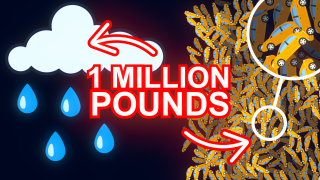More Than 10 INSANE Facts About Water
Published: November 16, 2022 at 8:59 PM (PT)
5:00
(9000 frames/30fps) Resolution:1920x1080
(FHD) Most Rewatched:0:54 to 1:06 Realtime Statistics...
30 Minutes...
Hour...
24 Hours...
Information Sources
https://www.wikidoc.org/index.php/Water_(molecule)
Amount of Water on Earthhttps://www.usgs.gov/special-topics/water-science-school/science/how-much-water-there-earth
Molecules in a Water Drophttps://www.thoughtco.com/atoms-in-a-drop-of-water-609425
Weight of Waterhttps://www.livestrong.com/article/530378-what-is-the-unit-weight-of-water
NASA Planetary Factsheethttps://nssdc.gsfc.nasa.gov/planetary/factsheet/planet_table_british.html
Cloud Weighthttps://www.usgs.gov/special-topics/water-science-school/science/how-much-does-cloud-weigh
Three States of Waterhttps://www.ck12.org/earth-science/states-of-water/lesson/states-of-water-hs-es
Water Factshttps://en.wikipedia.org/wiki/Hydrosphere
Antarctica Holds 70% of all Fresh Waterhttps://www.nsf.gov/pubs/1997/antpanel/3enviro.htm
Antarctica Factshttps://nsidc.org/learn/parts-cryosphere/ice-sheets/ice-sheet-quick-facts
Water is the Universal Solventhttps://www.usgs.gov/special-topics/water-science-school/science/water-universal-solvent
Pure Water can Dissolve Metalhttps://www.yahoo.com/news/insane-golden-chamber-contains-water-080000465.html
Where the Waters Runhttps://www.youtube.com/watch?v=Ojvibc9y1zs
Volume of a Glass of Waterhttps://www.quora.com/What-is-the-volume-of-one-generic-glass-as-in-8-glasses-of-water-per-day
Average Lake SizeN/A (painstakingly calculated from dozens of sources)
pH of Waterhttps://www.usgs.gov/special-topics/water-science-school/science/ph-and-water
pH of Lemon Juicehttps://www.medicinenet.com/what_is_the_ph_of_lemon_juice_acidic_or_alkaline/article.htm
pH of Soaphttps://www.ncbi.nlm.nih.gov/pmc/articles/PMC4171909
pH Represents "Potential Hydrogen"https://www.eskawater.com/the-importance-of-ph-2
Water is the Only Liquid that Expands When Frozenhttps://www.lpi.usra.edu/education/explore/ice/activities/ice_action/expanding_ice
Graphic Sources
https://pixabay.com/vectors/water-drop-liquid-fluid-nature-8904702
Clouds (Daniel Roberts)https://pixabay.com/vectors/clouds-outline-sky-cartoon-flat-7830508
Speed of Light Video (Daniel Roberts)https://www.youtube.com/watch?v=js_6UeLx-_c
Antarctica (Unknown)N/A
Grass (Unknown)N/A
Snowflake (Daniel Roberts)N/A
Trout (Clker-Free-Vector-Images)https://pixabay.com/vectors/trout-fish-rainbow-trout-animal-294469
Audio Sources
N/A
Fallen Comrade (Daniel Roberts)https://pixabay.com/music/main-title-fallen-comrade-20788
Pops1 (Daniel Roberts)N/A
Camera rabid wind lever 01 (Daniel Roberts)N/A
Deep Open (Daniel Roberts)https://pixabay.com/music/solo-piano-deep-open-9284
Ice cracking 01 (Unknown)N/A
0050_explosion_blast_2_PremiumBeat (Detonate, PremiumBeat)https://www.premiumbeat.com/blog/free-explosion-sfx-vfx-elements
Water is the most abundant molecule on Earth.
So abundant, in fact, that if Earth lost 10 trillion drops of water every second,
it would take over 80 thousand years for Earth to lose all of its water!
Of course this isn't too surprising since Earth's water weighs over 1.5 quintillion tons.
Which believe it or not is only about 0.0002% of all Earth's mass!
Although every cloud in the sky weighs around 1 million tons.
So they're not actually light and fluffy at all,
they are uh...
heavy and fluffy...
which doesn't make any sense...
Anyway, water is the only substance on Earth that can be naturally found in three forms.
The three forms being liquid, solid, and gas.
When it's in it's liquid form it's typically referred to as water...
you didn't know that...
right?
In it's solid form it's typically referred to as ice...
that was news to absolutely no one.
And in it's gaseous form it's typically referred to as water vapor or
[*clears throat]
steam.
Of course it's gas form has nothing to do with gasoline.
Don't get those two confused or you'll end up with a worse situation
then that time you tried to use a laser pointer as a jack.
Oh and remember how there's like some 1.5 quintillion tons of water on Earth?
Well, most of that water is actually salt water.
97.5% to be not exact, but as close to exact as science can figure.
If you want some fresh water you've got to head over to Antarctica.
Where some 70% of our fresh water is.
Now, don't get confused, there's not like a giant fresh water lake in Antarctica.
Oh no, it's far to cold for that,
all that fresh water is located in the 7.2 million cubic miles of ice there.
Most of Earth's fresh water is frozen.
30% of the Earth's fresh water is located in the ground,
in the form of...
you guessed it...
groundwater.
Oh, and we can't forget the billions of lakes and rivers that make up a whole uh...
0.1% of the Earth's water.
And rather shockingly, this nearly invisible and tasteless liquid,
can dissolve more substances than any other liquid on the planet.
It can even dissolve metals!
Hence why it's often referred to as the Universal Solvent.
Of course, it can't dissolve everything.
I mean if you put some oil in water you'll find that out pretty quickly.
Now while it can dissolve metal, it's important to note that most metals
will only dissolve slightly in water.
This is because after some time there is a coating formed around the metal known as rust.
And, of course, rust largely protects the inner metal from the water.
When referring to water here we're referring to pure water.
Pure water, is simply H2O.
Which, by the way, does not mean that it converts hamsters to ostriches.
It simply means that there are 2 hydrogen atoms and 1 oxygen atom in 1 water molecule.
There are about 1.5 sextillion water molecules in one drop of water.
Which means there's about 7 septillion molecules in 1 glass of water,
about 3 undecillion molecules in a lake,
and about 5 octodecillion molecules on Earth.
Don't worry about remembering those numbers though,
just remember that pure water has a pH of around 7.
For comparison lemon juice as a pH of around 2 and soap has a pH of around 10.
The pH of course representing "potential hydrogen"
which probably didn't help any.
Just know that pH represents the acidity of the substance.
The lower the pH the higher the acidity and the higher the pH the lower the acidity.
0 being the lowest pH and 14 being the highest pH.
When frozen, water expands by about 9%.
Actually, that's a very pathetically simple way of putting it
but we'll get to that a bit later.
When water expands it can create enormous pressure.
So much pressure, in fact, that if you filled an iron sphere with water
and then froze it,
the water would expand and the iron sphere would explode!
That is quite some energy!
Anyway, back to the pathetically simple 9% expansion statement.
Most liquids, such as paraffin wax and oil, get more dense when cooled.
And water, as a liquid, also get's more dense as it cools.
You're probably now confused as to why it expands but it also shrinks.
This is because water shrinks in volume until about 40°F.
Then the water suddenly stops condensing (or shrinking) and begins expanding.
As it expands it of course get's less dense.
This is the reason why ice floats on the surface.
And because it floats on the surface,
it keeps much of the water underneath from further freezing.
Water is the only liquid on the entire planet that expands when frozen.
And if it weren't for this amazing singularity in it's design,
ice would simply sink and more ice would form on the surface.
This would continue until all the streams, ponds, lakes, rivers, and even the ocean
were completely frozen and the Earth would become a massive ball of ice.


 November 16, 2022
November 16, 2022